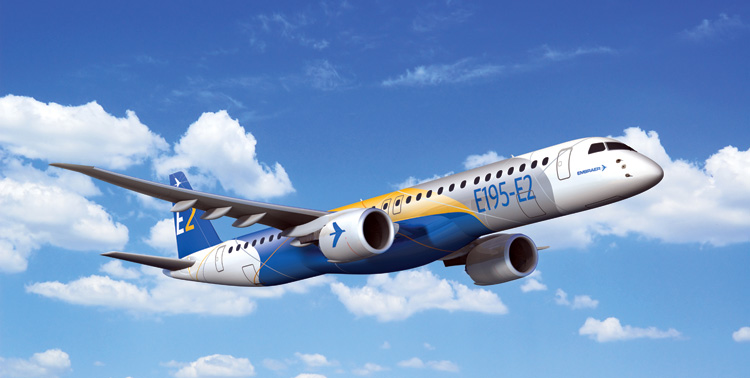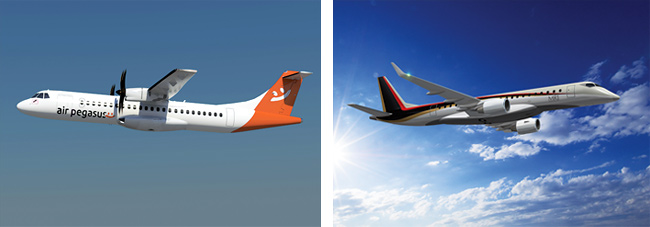Regional Aircraft Step Up
The next few years may see large-scale induction of smaller regional aircraft to replace existing fleets as well as to facilitate expansion of regional networks across the country

The world’s fastest growing aviation market needs aircraft urgently. According to the global airlines body the International Air Transport Association (IATA), India’s domestic air passenger traffic increased by 20.2 per cent in 2015 over the previous year. Aerospace major Boeing predicts this huge volume of growth will require a flood of new aircraft – 1,740 over the next 20 years. But the popular Boeing B-737 and Airbus A320 can operate only at approximately a third of India’s airports. Most regional airports either have insufficient runway length or other restrictions that permit only smaller aircraft. Therefore, analysts believe that around 200 smaller aircraft will be required in the next five years alone. What options do the country’s carriers have as they consider purchasing new aircraft?
Various regional aircraft already crisscross the skies. Alliance Air (Air India’s wholly-owned subsidiary) has a leased fleet of three Bombardier CRJ700 70-seat jets besides four ATR 42-320 (48-seater) and five ATR 72-600 (70-seater) turboprop aircraft. Another ten ATR 72-600s will be dry-leased soon. Jet Airways has 15 ATR 72-500s (68 seats) and three ATR 72-600s. SpiceJet operates 15 Bombardier Q400 turboprops in 78-seat configuration. Vijayawada-based regional airline Air Costa which already has four Embraer regional jets plans to expand to ten 112-seat Embraer E-190s by the end of the year. Another regional carrier, Hyderabad-based TruJet, started with three ATR 72-500 aircraft and aims to have ten by the year end. Bengaluru-based Air Pegasus has just two ATR 72-500 aircraft but intends to get another two shortly. And Coimbatore-based regional carrier Air Carnival plans to launch with two ATR 72-500 aircraft.
Apart from these tried-and-tested aircraft from market leaders Bombardier of Canada, Embraer of Brazil, and French-Italian aircraft maker Avions de Transport Régional (ATR), other options are emerging that will offer India’s airlines double-digit cost advantages and performance improvements over current airliners.
Bombardier’s Biggest Bet – the CSeries
Bombardier Aerospace is widely credited with sparking the modern regional jet revolution with its 50-seat CRJ100/CRJ200 Canadair Regional Jets (CRJ), in service since 1992. A quarter of a century later, despite 1,900 CRJ orders under its belt, Bombardier is in a do-or-die situation. And the source of its financial woes as well as its best hope to emerge a winner is an all-new twin-engine, medium-range regional jet that rejoices in the unlikely name of CSeries. The CSeries development programme has already cost $5.4 billion – $2 billion over budget – and Bombardier needs government assistance to survive. Besides, the project is at least two years behind schedule.

The CSeries has two variants – CS100 (110-130 seats) and CS300 (130-160 seats). The CS100 secured type certification from Transport Canada in December 2015 and is scheduled to enter service in the second quarter of 2016 with Swiss International Air Lines. The larger CS300 is expected to obtain its type certificate in four months.
The CSeries combines advanced materials, cutting-edge technology and proven commercial techniques. Its main attraction is fuel economy – around 20 per cent fuel savings, thanks to a composite fuselage and Pratt & Whitney’s new fuel-economising PurePower Geared Turbofan (GTF) engine, the PW1524G.
The CSeries order book now stands at 678 total orders and commitments. Of these, just 243 are firm orders (53 CS100 and 190 CS300) and none have been added since September 2014. Although the tally is well short of Bombardier’s oft-stated target of 300 firm orders before service entry, the CSeries hasn’t done too badly because this constitutes almost half the firm orders for aircraft seating 100-150 passengers since 2008. However, analysts believe the CSeries needs at least one more large firm order soon, preferably from a North American carrier, to keep it in serious contention in the regional jet market.
Paradoxically, some of the CSeries’ problems are due to steeply falling oil prices. With oil prices plunging about 70 per cent since June 2014, why would carriers be tempted to order fuel-efficient aircraft at premium prices? The highly-experienced Airbus and Boeing that decided to upgrade the A320 and B-737 respectively, rather than pursue the more risky clean-sheet option, can provide deep discounts to lure customers – offers that Bombardier and other regional jet manufacturers cannot match. Bombardier however estimates that 7,000 regional jets will be sold over the next 20 years and hopes to corner half the market. It has decided to play for all or nothing and is ramping up to produce 15 to 20 CSeries jets this year, accelerating to 120 aircraft annually by 2020.
Embraer’s Efforts: the E-Jet E2 Family
Since Embraer’s E-Jets entered service in 2004, they have enjoyed enviable commercial success. This family of four regional jets (70-130 seats) has secured about 1,700 orders and crossed 1,200 deliveries to over 70 customers. Embraer responded to the demand for modern fuel-efficient regional jets by adopting a more conservative route than Bombardier. It decided simply to re-wing and re-engine its E-Jets and add a full fly-by-wire flight control system to produce the new E-Jet E2. The E2 project may cost just $1.7 billion, keeping Embraer’s market risk far below that of Bombardier’s.
Embraer unveiled the first E-190-E2 on February 25, 2016. This 106-seat aircraft has P&W’s PW1900G engines, hung on new wing pylons and promises double-digit reduction in noise, emissions and fuel burn. It is planned for first flight later this year and delivery in the first half of 2018. It will be followed by the E-195-E2 (132 seats in single-class configuration) also with PW1900G engines in 2019, while the E-175-E2 (up to 88 passengers) with PW1700G engines will be delivered last in 2020. In February, Embraer announced that the E-195-E2 will gain 1.4 metres of wingspan and up to 450 nm of range. Thus far the E-Jets E2 account for 267 firm orders and 373 options – not bad considering that first delivery is still two years away.

Asian Attempts
Five years after entering commercial service, Russia’s Sukhoi Superjet 100 (86-103 seats) has a limited but significant presence in the market. The Commercial Aircraft Corporation of China (COMAC) too has long endeavoured to produce a modern regional aircraft and its ARJ21 Xiangfeng jet completed its first flight way back in 2008. However, the ARJ21 has been plagued by numerous delays and is about to enter service with launch customer Chengdu Airlines almost nine years behind schedule. General Electric CF34-10 engines power the ARJ21-700 baseline model (70-95 seats) and the ARJ21-900 stretched fuselage version (95-105 seats).
China is trying to produce its own turboprop airliner too. First proposed in 2007, the Xi’an Modern Ark 700 (MA700) is a twinengine, medium-range turboprop under development by the Aviation Industry Corporation of China (AVIC). Its first flight is expected in 2017 and it has reportedly secured 185 domestic orders.
However, the steep decline in oil prices may dent the global turboprop market hitherto dominated by various ATR models, with Bombardier’s Q400 a worthy competitor. Passengers prefer jets and the turboprop’s main commercial appeal is fuel efficiency, which is more significant when oil is expensive. With prices now dropping to around $30 a barrel the attraction of a new turboprop is considerably weakened. Hence regional jets may rule the roost unless the price of oil substantially increases.
Japan’s Mitsubishi Aircraft too is struggling with delays to its Mitsubishi Regional Jet (MRJ) originally due for delivery in the last quarter of 2013. The first flight finally happened only in November 2015 and the first delivery to All Nippon Airways is planned for the second quarter of 2018, almost five years after the original target. Mitsubishi plans to strengthen the airframe and upgrade software. It has also announced a reduction in the number of seats to reduce weight. The MRJ90 will now have 88 seats and the MRJ70 will have 76 seats. Consequently, the range will increase to 2,120 km and 1,880 km respectively. Mitsubishi has secured 407 MRJ orders, including 223 firm orders. A major cause for concern is that the first Embraer E-Jet E2 will also be delivered in 2018 which means that Mitsubishi has now sacrificed the headstart it had anticipated.
Murky Skies for the RTA-70
India’s new National Civil Aviation Policy is expected to include a clear thrust towards regional aviation. That is all to the good if the remote regions of the country are to enjoy the benefits of air travel. Thus the next few years are likely to see large-scale induction of smaller regional aircraft, jets and turboprops, to replace existing fleets as well as to facilitate expansion of regional networks across the country.
But shouldn’t a large country like India, with its growing technological prowess, make its own regional aircraft? It should. Much hope was reposed in the Regional Transport Aircraft (RTA- 70) project launched jointly in 2007 by the Hindustan Aeronautics Limited (HAL) and National Aerospace Laboratories (NAL). It was intended to design and develop a turboprop (perhaps even a turbojet) with a capacity of 70-100 passengers, specifically suited to the country’s short-haul requirements. In order to make it competitive, it would offer 25 per cent lower acquisition and operating costs and 50 per cent lower maintenance cost than existing turboprops.
The first flight was intended in 2013. But the claims were too good to be true and it now seems clear that the project is all but dead. HAL reportedly intends to float another tender inviting global aircraft manufacturers as partners to design and develop a new 50/80-seat regional aircraft. The project is estimated to cost Rs. 7,000 crore till certification.
However, a rethink may be warranted. If the much more modest Saras project to build an indigenous 14-seat aircraft had to be abandoned despite 16 years and Rs.300 crore down the drain, what realistic chance of success does an RTA type of project have? Besides, with so many good regional aircraft already scrambling for market share and more expected over the next few years, yet another would hardly make sense.
Some analysts ask, “If China can, why not India?” However, China’s efforts to develop modern passenger jets dates back to the Y-10 programme of the early 1970s and it too notched a string of ill-fated projects. Even though today, China is well ahead of India in aerospace manufacture, it had considerable difficulty in putting its long-delayed and over-budget ARJ21 regional jet into commercial service. COMAC has secured about 350 orders for the ARJ21, practically all from China’s domestic airlines and many of them after considerable government pressure.
Would this work in India? India’s aviation market is much smaller and its airlines might stiffly resist pressure to ‘Buy Indian’ if the aircraft does not meet their requirements. Neither are exports likely in such a crowded market, unless the quality is good and the price relatively low. India does need to develop an indigenous commercial aerospace industry, but perhaps a more realistic start point than the RTA needs to be looked at.





